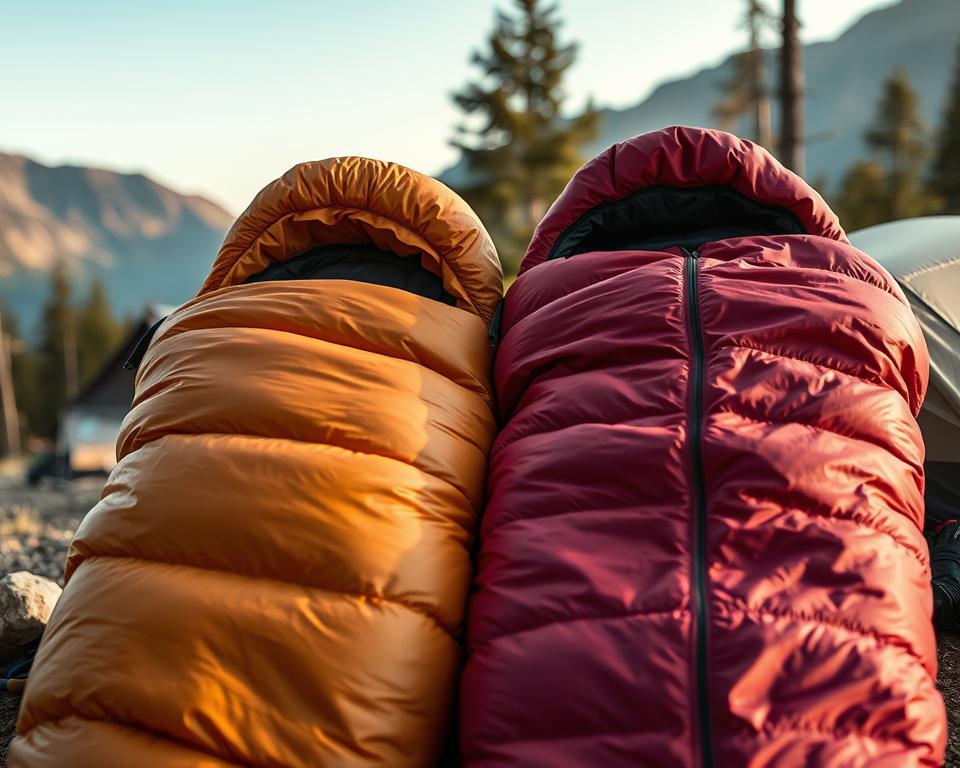Choosing the right gear is key when heading into the wild. One major decision is between down and synthetic sleeping bags. This choice affects comfort, warmth, and performance during your trip. Both down and synthetic bags offer unique benefits and downsides. Knowing these can impact your gear, insulation, and sleep outdoors.
Exploring the characteristics of each sleeping bag type is worthwhile. Whether it’s a tough backpacking trip or relaxed car camping, the right insulation makes a difference. Consider pack weight, weather conditions, and your budget in this choice.
The best sleeping bag, down or synthetic, means better sleep at night. Good rest means more energy and excitement for tomorrow’s adventures. Let’s look into the differences to find what’s best for you.
Introduction to Sleeping Bag Insulations
Understanding the differences between down and synthetic insulation is key to comfort when camping. Each type has its own benefits for your camping gear.
What is Down Insulation?
Down insulation comes from ducks or geese. It’s valued for its light weight, ability to compress, and warmth. Down’s fill power shows how well it traps heat, ranging from 600 to 1000.
The Enlightened Equipment’s 950-FP 20-degree Revelation Sleeping is a prime example. It weighs only 20.9 ounces and compresses to 7 liters. Down also keeps its loft up to three times longer than synthetics.
What is Synthetic Insulation?
Synthetic insulation, made from polyester, aims to act like down but excels in wet conditions. It dries fast and keeps you warm even when damp. However, it’s heavier and bulkier than down.
For example, the synthetic Revelation 20-degree Quilt weighs 30.1 ounces and needs 12.5 liters to compress. Still, it’s a go-to choice for those on a budget who need dependable warmth.
Importance of Choosing the Right Sleeping Bag
Choosing the right sleeping bag insulation is crucial. Consider your needs, activities, and the weather you’ll face. Down offers excellent comfort and durability, while synthetic works best in wet conditions and is more budget-friendly.
Ethical treatment of animals is ensured with responsible down standards. Synthetic options are good for those with allergies. Ultimately, the right sleeping bag can make or break your outdoor adventures.
Advantages of Down Sleeping Bags
Down sleeping bags are a top choice for many. They are loved by backpackers for their unique features. These bags mix comfort with outstanding functionality.
Compressibility and Lightweight
Down sleeping bags shine because they are light and easy to squash down. They have a high fill power. This means they take up little space. That’s essential when you need to carry less in your backpack.
These bags can shrink down to a tiny size. This is a big plus for backpackers. It cuts down on weight and space. Yet, they still keep you warm at night.
Superior Warmth-to-Weight Ratio
Down bags are known for their warmth without the weight. They are filled with high-quality down, from 650 to 900 fill power. This provides great insulation without being heavy. This is perfect when you need to keep warm but travel light.
On the other hand, synthetic bags are often heavier. They need more material for the same warmth. So, down bags are better for the cold, without the bulk.
Durability and Longevity
Down sleeping bags last a long time with the right care. A good one can be used for years. Down keeps its loft and warmth better than synthetic materials. This makes them a smart choice for regular outdoor trips.
Keep them clean with special down cleaners. Make sure they’re dry before storing. This will help your bag last longer and perform better on your adventures.
Drawbacks of Down Sleeping Bags
Down sleeping bags are known for being light and warm. But, they have drawbacks to think about before buying.
Ineffectiveness When Wet
Down sleeping bags don’t do well when wet. When they get wet, they lose their ability to keep you warm. The down clumps together, and this makes the bag less effective. Some bags are treated to resist water, but the problem is still there for those who love the outdoors in rainy places. Taking good care of your bag is crucial to keep it working well.
Cost Considerations
Thinking about the price is important. High-quality down bags can be costly. They are made from natural materials that need special treatment to stay fluffy and insulating. Synthetic bags cost less, but you should think about if the benefits of a down bag are worth the extra money.
Environmental and Ethical Concerns
The way down is sourced raises ethical issues. It comes from birds like geese and ducks. Nowadays, many companies follow the Responsible Down Standard (RDS). This makes sure the down is gathered ethically. If you care about ethical gear, make sure your down bag has RDS approval. It eases worries and ensures warm, guilt-free sleep.
Advantages of Synthetic Sleeping Bags
When heading into the wild, it’s key to have a sleeping bag that keeps you warm. Synthetic sleeping bags are a top pick for many campers. They bring great benefits that can’t be ignored.
Insulation When Wet
A highlight of synthetic bags is they keep you warm even if they get wet. Unlike down, synthetic fibers keep their shape and warmth in damp weather. This makes them perfect for trips where rain might be a guest. This feature becomes a lifesaver during sudden rainstorms or when morning dew visits.
Quick Drying Properties
Synthetic bags dry quickly. If it gets wet, it won’t be long before it’s dry and ready again. This means you can get back to exploring without waiting too long. I’ve seen how useful this is, especially during a trip that had 42 rainy days in a row.
Affordability
For new campers or those watching their wallets, synthetic bags are a budget-friendly choice. They’re made from materials like polyester, which are cheaper than down. This makes adventure possible for more people, keeping the cost low but maintaining quality.
Choosing the right sleeping bag is vital for a restful night outdoors. Synthetic bags excel in wet conditions, quick drying, and are friendly to your budget. They are a smart option for many explorers.
Down vs. Synthetic Sleeping Bags: Comparing the Key Factors
When picking a sleeping bag, think about weight, how easy it packs, warmth, and how long it lasts. Let’s look close at these points to help you choose right.
Weight and Packability
For backpackers, a sleeping bag’s weight and packability matter a lot. Down sleeping bags, especially with a 900+ fill power, are very light and compact. Synthetic bags, although getting better, are usually heavier and take up more space. But, if you’re looking to save money, synthetic bags offer a good deal despite the extra bulk.

Thermal Performance and Insulation
Down bags often lead in keeping you warm, made even better by high-quality Mature Goose Down. Yet, synthetic fills like PrimaLoft are doing well too, especially in damp places. Still, down usually stays warmer, except in wet conditions where synthetics can be warmer and dry quicker.
Durability and Maintenance
Thinking about durability and care is important. Down bags can last many years with right care, staying reliable. Synthetic bags might last about 5-7 years before their insulation drops. Good care helps both types last, but down needs special attention to keep its quality.
In the end, both down and synthetic sleeping bags have their upsides. Your choice depends on what matters most to you: ease of packing, warmth, or how long it lasts.
Down vs. Synthetic: Choosing Based on Your Adventure
Choosing between down and synthetic sleeping bags depends on your adventure type. Consider weight, warmth, compressibility, and how well they handle moisture. These factors are key to your choice.
Best Choice for Backpacking
Down sleeping bags are often best for backpacking. They are light and pack small, perfect for long treks. Mont uses hydrophobic Epic Thread in their Zero Ultralight Down Sleeping Bags. This keeps you warm, even in wet conditions.
Down bags are known for their warmth without much weight. The Big Agnes UL 0, though pricier, is very comfortable and efficient. It is important for backpackers choosing their bags.
Optimal Choice for Car Camping
Car camping means you don’t have to carry your gear. Synthetic sleeping bags shine here. They are cheaper and keep you warm, even if they get wet. Brands like Exped use STEALTH™ seam-welding for durable bags.
You can pack heavier bags and other car camping gear easily. Mont’s Evo Ultra Light is a great synthetic choice. It offers value and reliability without worrying about weight.
Suitability for Wet or Humid Conditions
In wet or humid places, go with synthetic sleeping bags. They dry fast and keep you warm even when wet. Exped’s bags are eco-friendly and meet OEKO TEX standards. They perform well.
Mont’s Hydronaute XT fabric is waterproof and windproof. It’s perfect for unpredictable weather. Choosing between down and synthetic depends on your needs and trip type. Know the strengths of each to make the best choice.
Whether it’s for backpacking sleeping bag selection guide or car camping gear, understanding each type’s benefits is crucial. This will help you decide wisely for your adventure.
How Does PrimaLoft Compare to Down Sleeping Bags in Terms of Performance?
When considering sleeping bags, it’s essential to understand the material’s performance. To evaluate warmth, weight, and water resistance, many outdoor enthusiasts want to know how both offer unique benefits. If you’re on the fence about insulation choices, you should compare primaLoft and down insulation options today for the best sleeping experience.
Conclusion
Choosing the right sleeping bag comes down to your needs and where you’ll use it. Down sleeping bags are best for staying warm and light during cold, dry trips. Synthetic bags, however, do better in wet conditions and are easier to care for. This guide has explained how each type’s features match different camping and backpacking needs.
If you’re heading into cold, dry places, down sleeping bags are unbeatable. They’re light, keep you warm, and last a long time. Synthetic sleeping bags shine in damp or humid areas. They keep you warm even if they get wet and are easier for beginners or those on a budget.
It’s important to think about how your bag affects animals and the planet. Down bags can be ethical if they meet certain standards, like the Responsible Down Standard (RDS). Synthetic bags don’t use animal products but can harm the environment because they’re made from oil. Luckily, eco-friendly options are becoming more common.
Your decision depends on what you value most: weight, warmth, cost, or being kind to the planet. Think about your trip type and the weather you’ll face. Our guide helps you weigh the benefits and drawbacks so you can choose the right bag. This way, you’ll enjoy your time outdoors, no matter your choice.

